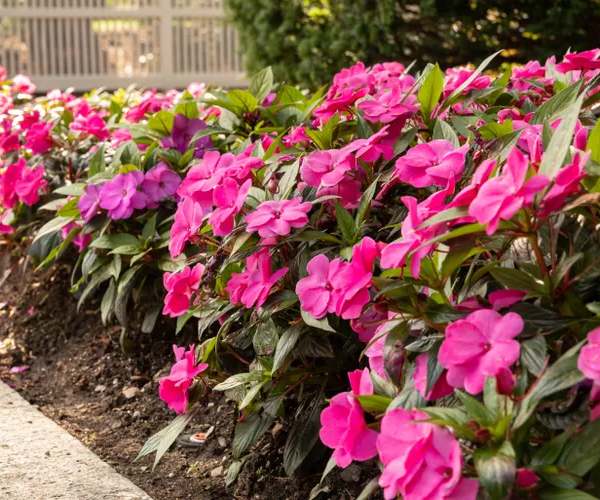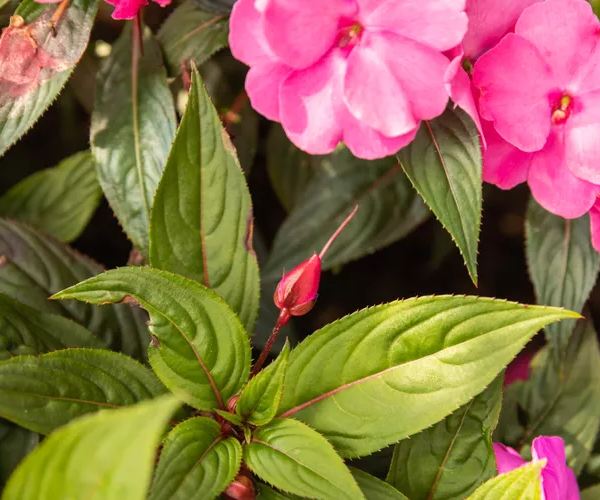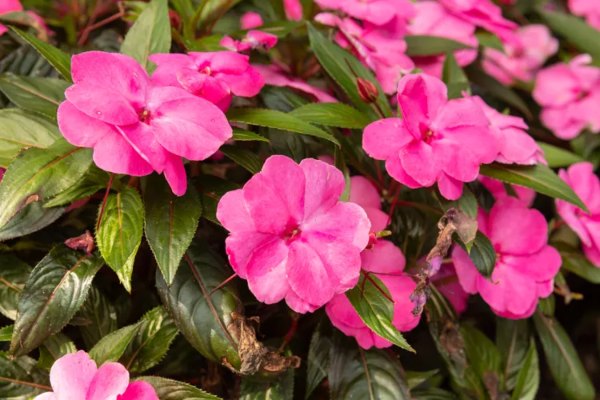New Guinea impatiens is a fast-growing, clump-shaped tropical plant that belongs to the balsam family and bears prolific, showy flowers in a variety of colors. This plant is a low-maintenance, and active option that blooms from spring to the first frost. It prefers mostly acidic soil. While it can tolerate full sun with afternoon shade, it does best in partial sun. Just like the shade-loving common inpatients, New Guinea can also grow in shadier spots.
This plant is mainly native to the US although it is perennial in the warmer, moist-climate USDA zones of 10 through 12.
Plant Attributes
- Common Name: New Guinea impatiens
- Botanical Name: Impatiens hawkeri
- Family: Balsaminaceae
- Plant Type: Annual
- Size: 12–18 inches tall, 6–9 inches wide
- Sun Exposure: Full, Partial
- Soil Type: Moist, but well-drained
- Soil pH: Acidic (6.0 to 6.5)
- Bloom Time: Spring, summer, fall, winter
- Hardiness Zone: Zones 10-12 (USDA)
- Native Area: New Guinea
New Guinea Impatiens Care
Here are some of the main care needs for growing a happy and healthy New Guinea Impatiens:
- Needs full or partial sun; tolerates shade although less light reduces bloom frequency.
- It is a perennial, returning each year, in USDA zones 10 through 12.
- Needs heavy feeding to produce prolific blooms.
- Grows better in acidic soil between pH 6.0 and 6.5.
- Grows in temperatures between 45 and 85 F; frost kills this plant, and sweltering heat makes it hard to thrive.
- Keep weed-free to reduce competition from other plants for nutrients or water.
- It can be grown in containers indoors and outdoors. If grown indoors, it will not flower all year round.
Light
The sun exposure your New Guinea impatiens requires totally depends on your climate’s moisture and temperature. This plant loves the morning sun and afternoon shade in a garden that has eastern exposure. If the sun is scorching hot, these plants will need more water and may not profusely.

Soil
This plant likes a bit of acidic soil with a range of 6.0 to 6.5 pH. Also, well-draining soil is important so that the roots hold moisture for a long time for their roots to be able to soak it up. These plants are heavy feeders. You need to add a good amount of organic matter to the soil just before planting. Once you’ve planted them in the ground, water them enough so that they can establish themselves.
Water
New Guinea impatiens grow better with regular watering. Do not keep them dry for a longer period otherwise, they will stop blooming and possibly die. These plants are not drought-tolerant but will die if left in prolonged soil for a longer time as their crowns will rot. Do not water from the top. You can also use a drip hose, if possible.
Temperature and Humidity
Only plant the New Guinea impatiens outside until the frost has passed and night temperatures are above 45F. The flowers love having day temperatures of 70 to 85 F and night temperatures of 55 to 65 F. They can do well in the high-humidity zones of 10, 11, and 12. Many gardeners also grow them as annuals. They purchase them as starts and then transfer them to the gardens.
Fertilizer
Since this plant grows all season long, they love supplemental fertilizer. Fertilize your plant with a balanced water-soluble food for blooming flowers every three to four weeks. If you want better results, reduce the regular dose by half and feed them every 1 1/2 to 2 weeks. You can also add some compost before planting or early and late in the season when they are grown as perennials.
Types of New Guinea Impatiens
This tropical plant features dark green, burgundy, variegated pointy leaves that look active and attractive throughout the season. Its orange, pink, red, white, and purple flowers are just like but a bit larger than those of common impatiens that feature five heart-shaped petals. They make a perfect addition to a pollinator garden and attract butterflies, bees, and other useful insects.
New Guinea impatiens are also hybridized. Here are some varietals coveted by growers:
- Impatiens ‘Paradise Rose Flair‘: This top-performing variety grows iridescent red-pink flowers all season long and is up to 16 inches tall and wide.
- Impatiens ‘Sun Harmony Baby Pink‘: This sun-tolerant type yields 2-inch-wide soft pink flowers that bloom all summer; it matures to 20 inches tall and wide.
- Impatiens ‘Sunstanding Salmon‘: This cultivar produces coral-colored blooms, grows in shady to full sun areas, looks great in containers, and maxes out at 36 inches tall and wide.
- Impatiens ‘Sunstanding Glowing Scarlet‘: This variety grows bright orange flowers with heart-shaped petals all summer, reaching 36 inches tall and wide at full maturity.
- ‘Celebration Lavender Glow’: Flowers have a purple hue
Also, Read A Complete Guide to Grow and Care for Hens and Chicks Plants
Pruning
New Guinea impatiens need some pruning during mid-summer to increase the blooms and that also helps promote a bushier and gives the plant a lush look. But, if you are content with the flower production and its appearance is full, you can skip pruning. Pruning should include deadheading of faded blooms.
Cut the stems that are leggy and produce more foliage than blooms. If the plants become spindly, do not cut back more than 16 inches.
Propagate New Guinea Impatiens
You can purchase readily available impatiens from your nearby nurseries an there are varieties of it. However, you can also easily grow them from cuttings if you want to save money or if you love the particular cultivar that you can’t find at te nurseries.
Here’s how you can propagate New Guinea impatiens from cuttings:
- You require garden shears, alcohol wipes, a glass, a pot, and soil.
- Disinfect your shears by wiping the blades with an alcohol wipe.
- Choose a healthy stem and cut 4 to 6 inches below the bloom.
- Remove the leaves from the bottom of the cutting, leaving only the top two leaves.
- Keep the new cutting’s bottom in a glass of water place it in a window that gets enough sunlight and wait until it starts rooting.
- Fill a pot with potting mix, water it, and allow it to drain.
- Make a hole in the soil and keep your cutting in the hole. Cover up all the roots and an inch of the stem.
- Keep the pot in a sunny indoor area. Harden it off by relocating it outside for a few days before it is ready to transplant into your garden.
Potting and Repotting New Guinea Impatiens
New Guinea Impatiens are great as pot flowers and can make your home look beautiful. Here is how to pot them:
- Select a container with good drainage.
- Add a thin layer of pebbles before adding soil to the pot.
- If the plant looks root-bound then gently remove them from their package and separate the roots at the bottom.
- Relocate them in the container and cover the roots entirely.
- Water the pot thoroughly and let the water drain before keeping it in an outside sunny location.
Common Pests & Plant Diseases
Just like common impatiens, New Guinea impatiens can also be affected by aphids and spider mites which damage the plants by sucking the juices. You can treat it by first reducing the insects with a garden hose spray. Then use an insecticidal soap to get rid of the insects.
There is no cure for Necrotic spots and tomato-spotted wilt that happens because of thrips. So, prevention is better than cure. Eliminating thrips will thwart the chances of disease moving in.

Downy mildew, botrytis blight, and verticillium wilt are fungal conditions are result from soggy soil. You can take care of this by maintaining a regular watering schedule and increasing the space between the plants. Once these diseases happen, downy mildew can only be controlled by removing the diseased plant.
FAQs
Q: How long do New Guinea impatiens last?
A: Most New Guinea impatiens are annuals, lasting for one full growing season in most U.S. zones. However, in Zones 10 through 12, they are perennials and will return every year when properly cut back and cared for.
Q: What are the differences between common impatiens and New Guinea impatiens?
A: New Guinea impatiens (Impatiens hawkeri) is a sturdier, bushier species similar to common impatiens (Impatiens walleriana). A key difference is it produces larger blooms, grows taller, and requires more sunlight.
Q: What kinds of light do New Guinea impatiens require?
A: New Guinea impatiens prefer partial sun and thrive in morning and afternoon shade. Intense sun or deep shade will likely affect flower production.
Q: Where should you place New Guinea impatiens?
A: It works great for edging a walkway or as a border in front of a garden. When incorporated this way, plant impatiens in a large block for a dramatic impact. It can also grow in a pot in a container garden.
Q: Why are New Guinea impatiens considered a “hybrid” varietal ?
A: Sun-loving New Guinea impatiens have been cultivated by crossing several closely related species selected specifically for certain traits. New Guinea impatiens were developed to withstand more sun than the common varieties; however, they still prefer afternoon shade.
Q: How do you encourage New Guinea impatiens to spread?
A: Plant your starts about 18 inches apart in a mixture of soil and compost. Maintain proper conditions, like light and soil, and then prune plants once they look leggy. Clipping back spindly stems, in addition to perfect growing conditions, will encourage fuller growth.
Also, Read Top 10 Poisonous Plants to Keep Out of Your Garden for Dog’s Safety
